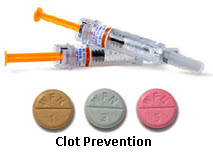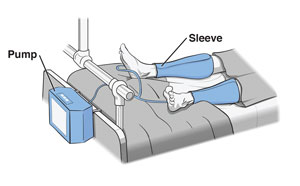Preventing Deep Vein Thrombosis(DVT)
You have a higher chance of developing a deep vein thrombosis (DVT), or blood clot in the vein. They are most common in the leg. But, a DVT may develop in an arm, or another deep vein in the body. A piece of the clot, called an embolus, can break off from the vein and travel to the lungs. A blood clot in the lungs is called a pulmonary embolus (PE). This can cut off the flow of blood. It is a medical emergency and may cause death.
Preventing a DVT is important. Here are four things that can help prevent a DVT:

|
 |
|
Anticoagulant.
-
Your provider will order a medicine that prevents blood clots.
-
You take it by mouth, by injection, or through an IV.
-
Common anticoagulants include, but are not limited to: warfarin, heparin, and enoxaparin.
-
It is important that they discuss the risks and benefits with you.
|
Walking & Exercises.
-
Simple exercises while you are in bed or sitting in a chair can help prevent DVT.
-
Move your feet in a circle or up and down.
-
Do this 10 times an hour to improve circulation.
-
If in the hospital, a nurse will help you out of bed, as soon as you are able.
-
Moving around improves circulation and helps prevent blood clots.
|
 |
|
|
SCD's (Sequential compression devices)
-
Sleeves are wrapped around your legs and connected to a pump that inflates and deflates the sleeves.
-
The pump applies gentle pressure to promote blood flow in the legs and prevent blood clots.
-
They should be on legs when you are not walking, this includes sitting in a chair.
|
Drinking water:
-
Drink at least 8 glasses (64 oz) of water every day. Unless a different amount is recommended by your provider.
-
Fill a pitcher of water to help you track the water you are drinking.
-
Water helps improves general health and helps prevent DVT.
|
When to get help
Call 911 right away if you have any of the following:
-
Chest pain
-
Shortness of breath
-
Fast heartbeat
-
Excessive sweating
-
Fainting
-
Coughing up blood
-
Pain, swelling, redness, or warmth in the leg, arm, or other area
Call your health care provider right away, or get emergency help if you are bleeding or have signs of bleeding such as:
-
Heavy or uncontrolled bleeding
-
Blood in the urine or stool
-
Very dark or tar-like stool
-
Vomiting blood
© 2000-2025 The StayWell Company, LLC. All rights reserved. This information is not intended as a substitute for professional medical care. Always follow your healthcare professional's instructions.